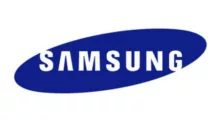
Samsung Galaxy S III (2012)
The manufacturer offers this phone with a 4.8 inch Super AMOLED display, a Qualcomm Snapdragon S4 Plus MSM8960 chipset, and 2 GB of RAM.
Is this phone worth its price? Hopefully, it will become clear by the end of my review.
Table of Contents
- Samsung Galaxy S III specifications
- Weight, dimensions, colors
- System, chipset, performance
- Display type, size, resolution
- Memory, storage
- Cameras, flash
- Connectivity, network, wireless
- Battery type, capacity, charger
- Features, sensors, specials
- Verdict, pros and cons
This article shares our personal experiences and thoughts about using the Samsung Galaxy S III smartphone. We hope to offer helpful insights to others interested in this device.
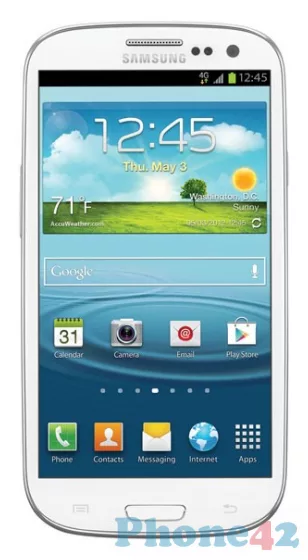
Samsung Galaxy S III specifications
| Brand | Samsung |
|---|---|
| Name | Galaxy S III |
| Model | SPH-L710 |
| Release date | 2012 |
Weight, dimensions, colors
| Weight | 4.69 oz |
|---|---|
| Dimensions | 5.4 x 2.8 x 0.3 inch |
| Colors | marble white, pebble blue, purple |
| SIM type | Micro SIM |
The weight of the Samsung Galaxy S III is still considered to be lightweight and portable. A micro SIM is larger than the current standard Nano SIM card but smaller than the older SIM card size.
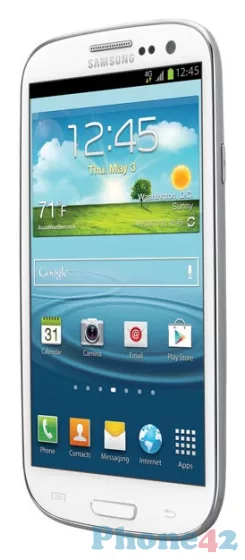
System, chipset, performance
| OS version | Android OS v4.3 (Jelly Bean) |
|---|---|
| SoC | Qualcomm Snapdragon S4 Plus MSM8960 |
| CPU | Dual-core 1.5 GHz Krait |
| GPU | Adreno 225 |
The Samsung Galaxy S III comes with Android OS v4.3 (Jelly Bean) out of the box. Android is an open-source operating system. This means users and developers have more control over the software. This CPU can be fast enough for basic phone operations. Smartphones, tablets, and other mobile devices use Adreno GPUs.
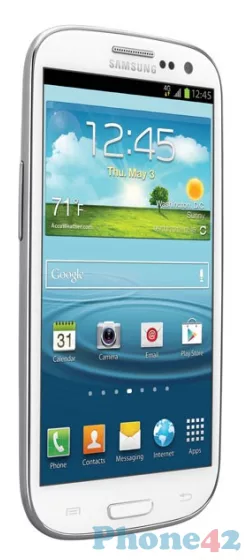
Display type, size, resolution
| Display type | Super AMOLED |
|---|---|
| Screen size | 4.8 inch |
| Resolution | 720 x 1280 px |
| Multitouch support | yes |
The Galaxy S III's AMOLED display has deep blacks and vibrant colors. It also has fast response times and features like Always-On Display. Smaller smartphones are generally more compact and easier to handle. The display size is the diagonal distance from one corner of the screen to the opposite corner.
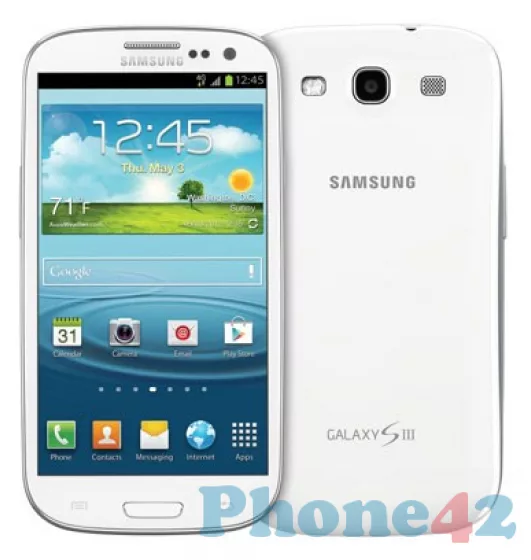
Memory, storage
| RAM | 2 GB |
|---|---|
| Internal storage | 16 GB |
| Memory card slot | microSD |
The smartphone has 2 GB of RAM. It can run many apps at once without much lag or slowness. More RAM lets us keep more apps and processes open in the background. This keeps the device from slowing down. If we use our smartphones for basic tasks like calling, texting, and browsing the web, 32 GB may be sufficient for our needs. We can expand the internal storage of the Galaxy S III (16 GB) by using a compatible microSD card.

Cameras, flash
| Main camera | 8 MP, 3264 x 2448 px, autofocus |
|---|---|
| Flash | LED |
| Selfie camera | 1.9 MP |
This single camera can be enough for many smartphone users, it depends on their photography needs and preferences. The main camera of Galaxy S III smartphone does not have OIS. The optical image stabilization (OIS) is an important feature in smartphones.

Connectivity, network, wireless
| GSM 2G bands | 850 / 900 / 1800 / 1900 |
|---|---|
| Network coverage | 2G / 3G / 4G |
| Wi-Fi | Wi-Fi 802.11 a/b/g/n |
| Bluetooth | v4.0, A2DP |
| GPS | A-GPS |
| NFC | yes |
| FM radio | no |
| USB | microUSB 2.0, USB host |
| Headphone | 3.5 mm jack |
The 4G provides faster data transfer speeds compared to previous generations. The Galaxy S III supports the latest Wi-Fi standards. We can use Bluetooth to connect our Galaxy S III smartphone to many Bluetooth devices. The Galaxy S III has a GPS receiver. Many fitness and activity tracking apps rely on GPS. It is used to accurately measure and record outdoor activities. The Galaxy S III comes with NFC (Near Field Communication) functionality. The 3.5 mm headphone jack allows us to connect wired headphones or earphones to the device.

Battery type, capacity, charger
| Type | Li-Ion 2100 mAh |
|---|
The Li-Ion 2100 mAh battery gives the smartphone a good battery backup. The Li-ion is a low maintenance battery. It does not need periodic full discharge. We can simply buy a new battery from the open market and interchange it by ourselves.
Features, sensors, specials
| Sensors | accelerometer, barometer, compass, gyroscope, proximity |
|---|---|
| Specials | Corning Gorilla Glass 2 |
Today, smartphones come with many sensors. They help make the user experience better. The accelerometer is a sensor. It measures the tilting motion and orientation of the phone. Corning Gorilla Glass is tougher. It resists scratches, impacts, and drops.
Verdict, pros and cons
Every phone has its strengths and weaknesses, and this Samsung phone is no exception. As with any device, there are aspects that shine and others that fall short. By examining both sides, we can paint a complete picture of what this phone has to offer. Let's explore its standout features and areas for improvement. Remember, this is just my opinion, and yours might be different.
Pros
- Super AMOLED display
- microSD slot
- Corning Gorilla Glass shield
Cons
- limited-size screen
- insufficient internal storage
- single camera setup
- no OIS function
- no 5G support
- no Type-C USB port
- low-capacity battery
- no fingerprint reader
Please let us know if you find incorrect information or something isn't working. Also, tell us if you have a suggestion for improvement.
Updated: June 8, 2024
 I'm Lucas Bradley, the founder of the Phone42.com site. I love technology, especially smartphones, and I've been working with tech stuff for more than 20 years. This means I've seen a lot of changes and have learned a bunch about what makes a good phone. On Phone42.com, I look at all kinds of phones. They can be from big, well-known companies or new ones trying to make their mark. I want to help people understand what's new and cool in the world of smartphones, in a way that's easy to get.
I'm Lucas Bradley, the founder of the Phone42.com site. I love technology, especially smartphones, and I've been working with tech stuff for more than 20 years. This means I've seen a lot of changes and have learned a bunch about what makes a good phone. On Phone42.com, I look at all kinds of phones. They can be from big, well-known companies or new ones trying to make their mark. I want to help people understand what's new and cool in the world of smartphones, in a way that's easy to get.